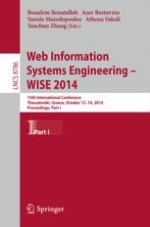2014 | Book
Web Information Systems Engineering – WISE 2014
15th International Conference, Thessaloniki, Greece, October 12-14, 2014, Proceedings, Part I
Editors: Boualem Benatallah, Azer Bestavros, Yannis Manolopoulos, Athena Vakali, Yanchun Zhang
Publisher: Springer International Publishing
Book Series : Lecture Notes in Computer Science
